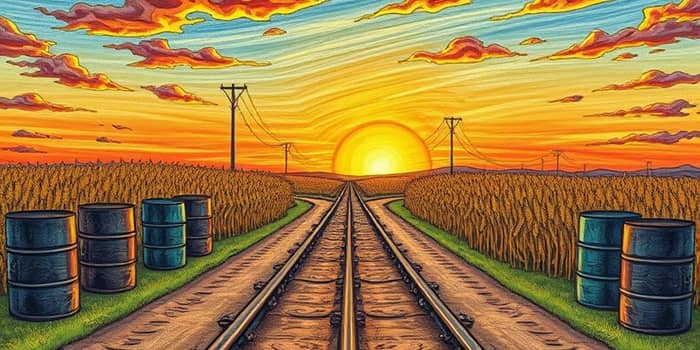As we enter September 2025, the global commodity landscape stands at a pivotal intersection. With forecasts pointing toward widespread price declines, stakeholders must adapt, innovate, and strategize to turn uncertainty into opportunity.
Macro Trends Shaping the Outlook
Global commodity prices are expected to fall by 12% drop in 2025 and a further 5–6% in 2026, pushing real prices below the 2015–2019 average for the first time. This contraction is driven by a sharper global economic slowdown, sustained supply chain recovery, and technological shifts such as electric vehicle adoption.
Policymakers and investors alike will watch how these forecasts intertwine with broader inflation and growth trajectories. The projected decline exerts downward pressure on inflation globally, offering a reprieve from recent spikes but raising questions about long-term demand.
Energy Commodities: A Sector in Flux
Energy prices are set to experience the steepest corrections. The World Bank forecasts a 17% drop in 2025 and an additional 6% in 2026. Brent crude is expected to average $64 per barrel in 2025 and slip to $60 in 2026, though the EIA suggests a more bearish $51 per barrel by 2026.
Temporary market correction or new long-term baseline? As EVs gain market share and OPEC+ debates its cutbacks, oil supply may outpace demand, exerting further downward pressure. U.S. production is forecast to average 13.4 million barrels per day in 2025, dipping slightly in 2026 as drilling slows in response to weaker prices.
Natural gas and coal are not spared. Expanded output, coupled with stagnant demand in key markets, points to continued softness through the next two years.
Agricultural Commodities: Navigating Food Security
After surging in 2024, food and agricultural prices are projected to ease with grains down 11%, oils and meals down 7%, and other food commodities down 5% by end-2025. In 2026, indices are expected to stabilize, reflecting balanced global supplies and demand.
However, localized shocks remain a threat. Extreme weather, pest outbreaks, and renewed supply chain disruptions could spark unexpected price spikes, impacting vulnerable populations the hardest.
According to USDA forecasts, U.S. food prices will rise 2.9% in 2025 and slow to 2.2% in 2026, with at-home prices growing more slowly than away-from-home dining. Lowest nominal level since 2020 in vegetable prices offers consumers some relief, but volatility endures.
Metals and Minerals: Building the Future
Industrial metals see modest gains in 2024 before easing through 2025 and 2026. The World Bank anticipates small declines across copper, aluminum, and nickel, reflecting a cooling global manufacturing sector.
Yet the green transition fuels pockets of resilience. Demand for battery minerals such as lithium and cobalt may counteract cyclical downturns, underscoring how clean energy initiatives can reshape commodity dynamics.
Investment shifts amplify price volatility as institutional investors increasingly use commodities for portfolio hedging, synchronizing price movements across diverse markets.
Risks, Opportunities, and Strategic Responses
While forecasts point downward, the future remains unwritten. Stakeholders must prepare for both headwinds and potential surges.
- Sharper global economic slowdown: Could deepen price declines across all categories.
- Geopolitical turmoil: Disruptions in major energy-producing regions may trigger sudden price spikes.
- Extreme weather events: Threaten agricultural yields and create localized food crises.
- Technological acceleration: EV adoption could permanently reshape oil demand trajectories.
- Trade policy shifts: New agreements or barriers may realign supply chains.
- Green investment flows: Increased funding for battery minerals and renewable energy infrastructure.
- Diversify procurement strategies by sourcing from multiple regions to mitigate localized supply shocks.
- Invest in sustainable technologies such as clean energy and precision agriculture to build long-term resilience.
- Hedge exposures wisely using a mix of physical, futures, and options markets to manage volatility.
Comparative Projections at a Glance
Below is a concise overview of key commodity projections for quick reference.
Understanding these trajectories empowers businesses, policymakers, and communities to make informed decisions, from budgeting and procurement to strategic investments.
At this commodity crossroads, flexibility and foresight will determine who thrives amid shifting price landscapes and who risks being left behind.
By embracing data-driven strategies and sustainable innovations, stakeholders can not only weather the downturn but emerge stronger, capitalizing on the transformative forces reshaping global markets.
References
- https://www.ecofinagency.com/news/0205-46717-global-commodity-prices-set-to-fall-in-2025-and-2026-world-bank-says
- https://businessmonthlyeg.com/world-bank-forecasts-stable-commodity-prices-through-2026-barring-shocks/
- https://blogs.worldbank.org/en/developmenttalk/the-commodity-markets-outlook-in-eight-charts1
- https://openknowledge.worldbank.org/entities/publication/02d005ef-e3d9-44f5-aada-8ba42663a743
- http://www.ers.usda.gov/data-products/food-price-outlook/summary-findings
- https://www.eia.gov/outlooks/steo/
- https://tradingeconomics.com/forecast/commodity










